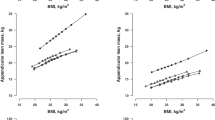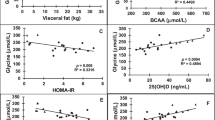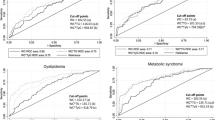Abstract
Background:
Research examining the relationship between adiponectin (AN) isoforms, body weight and cardiovascular (CV) risk factors is limited, particularly in younger populations.
Objectives:
To investigate the inter-relationships between AN isoforms and CV risk factors, and their dependence on body weight status, in adolescents.
Design:
Blood samples from 92 obese, 92 overweight and 92 normal weight age- and sex-matched adolescents were analysed for traditional cardiovascular disease (CVD) risk biomarkers and also total, high molecular weight (HMW), medium and low molecular weight (LMW) AN.
Results:
A significant inverse association was observed between total and HMW AN and waist-hip ratio (P=0.015, P=0.006, respectively), triglycerides (P=0.003, P=0.003, respectively) and systolic blood pressure (P=0.012, P=0.024, respectively) and a significant positive association with high-density lipoprotein (P<0.001, P<0.001, respectively) in multi-adjusted analyses. There was no evidence of a relationship between multimeric AN and high-sensitivity C-reactive protein. There was also little evidence of a relationship between LMW AN and CVD risk factors. There was a strong, body mass index (BMI)-independent, association between AN, CVD biomarkers and the hypertriglyceridemic waist phenotype.
Conclusion:
Prominent, BMI-independent associations between total and HMW AN, but not LMW AN, and CVD risk factors were already evident in this young population. This research in adolescents supports the contention that AN subfractions may have different biological actions. These associations in apparently healthy adolescents suggest an important role for AN and its subfractions in the pathogenesis of metabolic syndrome traits and indicate that the potential for total or HMW AN to act as early universal biomarkers of CV risk warrants further study.
This is a preview of subscription content, access via your institution
Access options
Subscribe to this journal
Receive 12 print issues and online access
$259.00 per year
only $21.58 per issue
Buy this article
- Purchase on Springer Link
- Instant access to full article PDF
Prices may be subject to local taxes which are calculated during checkout
Similar content being viewed by others
References
Kershaw EE, Flier JS . Adipose tissue as an endocrine organ. J Clin Endocrinol Metab 2004; 89: 2548–2556.
Ahima RS, Flier JS . Adipose tissue as an endocrine organ. Trends Endocrinol Metab 2000; 11: 327–332.
Shibata R, Ouchi N, Murohara T . Adiponectin and cardiovascular disease. Circ J 2009; 73: 608–614.
Bobbert T, Rochlitz H, Wegewitz U, Akpulat S, Mai K, Weickert MO et al. Changes of adiponectin oligomer composition by moderate weight reduction. Diabetes 2005; 54: 2712–2719.
Kratz M, Swarbrick MM, Callahan HS, Matthys CC, Havel PJ, Weigle DS . Effect of dietary n-3 polyunsaturated fatty acids on plasma total and high-molecular-weight adiponectin concentrations in overweight to moderately obese men and women. Am J Clin Nutr 2008; 87: 347–353.
Reinehr T, Roth C, Menke T, Andler W . Adiponectin before and after weight loss in obese children. J Clin Endocrinol Metab 2004; 89: 3790–3794.
Elloumi M, Ben Ounis O, Makni E, Van Praagh E, Tabka Z, Lac G . Effect of individualized weight-loss programmes on adiponectin, leptin and resistin levels in obese adolescent boys. Acta Paediatr 2009; 98: 1487–1493.
Zhu N, Pankow JS, Ballantyne CM, Couper D, Hoogeveen RC, Pereira M et al. High-molecular-weight adiponectin and the risk of type 2 diabetes in the ARIC Study. J Clin Endocrinol Metab 2010; 95: 5097–5104.
Sattar N, Wannamethee G, Sarwar N, Tchernova J, Cherry L, Wallace AM et al. Adiponectin and coronary heart disease: a prospective study and meta-analysis. Circulation 2006; 114: 623–629.
Kaser S, Tatarczyk T, Stadlmayr A, Ciardi C, Ress C, Tschoner A et al. Effect of obesity and insulin sensitivity on adiponectin isoform distribution. Eur J Clin Invest 2008; 38: 827–834.
Bluher M, Brennan AM, Kelesidis T, Kratzsch J, Fasshauer M, Kralisch S et al. Total and high-molecular weight adiponectin in relation to metabolic variables at baseline and in response to an exercise treatment program: comparative evaluation of three assays. Diabetes Care 2007; 30: 280–285.
Rizza S, Gigli F, Galli A, Micchelini B, Lauro D, Lauro R et al. Adiponectin isoforms in elderly patients with or without coronary artery disease. J Am Geriatr Soc 2010; 58: 702–706.
Baumann M, von Eynatten M, Dan L, Richart T, Kouznetsova T, Heemann U et al. Altered molecular weight forms of adiponectin in hypertension. J Clin Hypertens 2009; 11: 11–16.
Yiannikouris F, Gupte M, Putnam K, Cassis L . Adipokines and blood pressure control. Curr Opin Nephrol Hypertens 2010; 19: 195–200.
Antoniades C, Antonopoulos AS, Tousoulis D, Stefanadis C . Adiponectin: from obesity to cardiovascular disease. Obes Rev 2009; 10: 269–279.
Lara-Castro C, Luo N, Wallace P, Klein RL, Garvey WT . Adiponectin multimeric complexes and the metabolic syndrome trait cluster. Diabetes 2006; 55: 249–259.
Salani B, Briatore L, Andraghetti G, Adami GF, Maggi D, Cordera R . High-molecular weight adiponectin isoforms increase after biliopancreatic diversion in obese subjects. Obesity 2006; 14: 1511–1514.
Fisher FF, Trujillo ME, Hanif W, Barnett AH, McTernan PG, Scherer PE et al. Serum high molecular weight complex of adiponectin correlates better with glucose tolerance than total serum adiponectin in Indo-Asian males. Diabetologia 2005; 48: 1084–1087.
Hara K, Horikoshi M, Yamauchi T, Yago H, Miyazaki O, Ebinuma H et al. Measurement of the high-molecular weight form of adiponectin in plasma is useful for the prediction of insulin resistance and metabolic syndrome. Diabetes Care 2006; 29: 1357–1362.
Wang W, Xing W, Zhang H, Ding M, Shang L, Lau WB et al. Reduced high molecular weight adiponectin is an independent risk factor of cardiovascular lesions in hypercholesterolemic patients. Clin Endocrinol (e-pub ahead of print 22 May 2012; doi:10.1111/j.1365-2265.2012.04444.x.).
Ong KK, Frystyk J, Flyvbjerg A, Petry CJ, Ness A, Dunger DB . Sex-discordant associations with adiponectin levels and lipid profiles in children. Diabetes 2006; 55: 1337–1341.
Jeffery AN, Murphy MJ, Metcalf BS, Hosking J, Voss LD, English P et al. Adiponectin in childhood. Int J Pediatr Obes 2008; 3: 130–140.
Araki S, Dobashi K, Kubo K, Asayama K, Shirahata A . High Molecular Weight, Rather than Total, Adiponectin Levels Better Reflect Metabolic Abnormalities Associated with Childhood Obesity. J Clin Endocrinol Metab 2006; 91: 5113–5116.
Mangge H, Almer G, Haj-Yahya S, Pilz S, Gasser R, Moller R et al. Preatherosclerosis and adiponectin subfractions in obese adolescents. Obesity 2008; 16: 2578–2584.
Murdolo G, Nowotny B, Celi F, Donati MB, Bini V, Papi F et al. Inflammatory adipokines, high molecular weight adiponectin, and insulin resistance: a population-based survey in prepubertal school children. PLoS ONE 2011; 6: e17264.
Nakatani H, Hirose H, Yamamoto Y, Saito I, Itoh H . Significance of leptin and high-molecular weight adiponectin in the general population of Japanese male adolescents. Metab Clin Exp 2008; 57: 157–162.
Boreham C, Savage JM, Primrose D, Cran G, Strain J . Coronary risk factors in schoolchildren. Arch Dis Child 1993; 68: 182–186.
Cole TJ . A chart to link child centiles of body mass index, weight and height. Eur J Clin Nutr 2002; 56: 1194–1199.
McGartland CP, Robson PJ, Murray LJ, Cran GW, Savage MJ, Watkins DC et al. Fruit and vegetable consumption and bone mineral density: the Northern Ireland Young Hearts Project. Am J Clin Nutr 2004; 80: 1019–1023.
Watkins DC, Murray LJ, McCarron P, Boreham CA, Cran GW, Young IS et al. Ten-year trends for fatness in Northern Irish adolescents: the Young Hearts Projects–repeat cross-sectional study. Int J Obes 2005; 29: 579–585.
Tanner JM . Growth at Adolescence. Blackwell Scientific Publications: Oxford, 1962.
Lemieux I, Pascot A, Couillard C, Lamarche B, Tchernof A, Almeras N et al. Hypertriglyceridemic waist: A marker of the atherogenic metabolic triad (hyperinsulinemia; hyperapolipoprotein B; small, dense LDL) in men? Circulation 2000; 102: 179–184.
Esmaillzadeh A, Mirmiran P, Azizi F . Clustering of metabolic abnormalities in adolescents with the hypertriglyceridemic waist phenotype. Am J Clin Nutr 2006; 83: 36–46.
Vikram NK, Misra A, Pandey RM, Dwivedi M, Luthra K . Adiponectin, insulin resistance, and C-reactive protein in postpubertal Asian Indian adolescents. Metab Clin Exp 2004; 53: 1336–1341.
Valle M, Martos R, Gascon F, Canete R, Zafra MA, Morales R . Low-grade systemic inflammation, hypoadiponectinemia and a high concentration of leptin are present in very young obese children, and correlate with metabolic syndrome. Diabetes Metab 2005; 31: 55–62.
Mangge H, Almer G, Haj-Yahya S, Grandits N, Gasser R, Pilz S et al. Nuchal thickness of subcutaneous adipose tissue is tightly assocaited with an increased LMW/total adiponectin ratio in obese juveniles. Atherosclerosis 2009; 203: 277–283.
Liu Y, Retnakaran R, Hanley A, Tungtrongchitr R, Shaw C, Sweeney G . Total and high molecular weight but not trimeric or hexameric forms of adiponectin correlate with markers of the metabolic syndrome and liver injury in thai subjects. J Clin Endocrinol Metab 2007; 92: 4313–4318.
Martos-Moreno GA, Barrios V, Martinez G, Hawkins F, Argente J . Effect of Weight Loss on High-Molecular Weight Adiponectin in Obese Children. Obesity 2010; 18: 2288–2294.
Araki S, Dobashi K, Yamamoto Y, Asayama K, Kusuhara K . Increased plasma isoprostane is associated with visceral fat, high molecular weight adiponectin, and metabolic complications in obese children. Eur J Pediatr 2010; 169: 965–970.
Polak J, Kovacova Z, Jacek M, Klimcakova E, Kovacikova M, Vitkova M et al. An increase in plasma adiponectin multimeric complexes follows hypocaloric diet-induced weight loss in obese and overweight pre-menopausal women. Clin Sci 2007; 112: 557–565.
Schober F, Neumeier M, Weigert J, Wurm S, Wanninger J, Schaffler A et al. Low molecular weight adiponectin negatively correlates with the waist circumference and monocytic IL-6 release. Biochem Biophys Res Commun 2007; 361: 968–973.
Lara-Castro C, Doud EC, Tapia PC, Munoz AJ, Fernandez JR, Hunter GR et al. Adiponectin multimers and metabolic syndrome traits: relative adiponectin resistance in African Americans. Obesity 2008; 16: 2616–2623.
Lara-Castro C, Fu Y, Chung BH, Garvey WT . Adiponectin and the metabolic syndrome: mechanisms mediating risk for metabolic and cardiovascular disease. Curr Opin Lipidol 2007; 18: 263–270.
Brooks NL, Moore KS, Clark RD, Perfetti MT, Trent CM, Combs TP . Do low levels of circulating adiponectin represent a biomarker or just another risk factor for the metabolic syndrome? Diabetes Obes Metab 2007; 9: 246–258.
Choi KM, Yannakoulia M, Park MS, Cho GJ, Kim JH, Lee SH et al. Serum adipocyte fatty acid-binding protein, retinol-binding protein 4, and adiponectin concentrations in relation to the development of the metabolic syndrome in Korean boys: a 3-y prospective cohort study. Am J Clin Nutr 2011; 93: 19–26.
Morrison JA, Glueck CJ, Daniels S, Wang P, Horn P, Stroop D . Paradoxically high adiponectin and the healthy obese phenotype in obese black and white 16-year-old girls. Transl Res 2010; 156: 302–308.
Almeda-Valdes P, Cuevas-Ramos D, Mehta R, Gomez-Perez FJ, Cruz-Bautista I, Arellano-Campos O et al. Total and high molecular weight adiponectin have similar utility for the identification of insulin resistance. Cardiovasc Diabetol 2010; 9: 26.
Stern SE, Williams K, Ferrannini E, DeFronzo RA, Bogardus C, Stern MP . Identification of individuals with insulin resistance using routine clinical measurements. Diabetes 2005; 54: 333–339.
Basu R, Pajvani UB, Rizza RA, Scherer PE . Selective downregulation of the high molecular weight form of adiponectin in hyperinsulinemia and in type 2 diabetes: differential regulation from nondiabetic subjects. Diabetes 2007; 56: 2174–2177.
Weyer C, Funahashi T, Tanaka S, Hotta K, Matsuzawa Y, Pratley RE et al. Hypoadiponectinemia in obesity and type 2 diabetes: close association with insulin resistance and hyperinsulinemia. J Clin Endocrinol Metab 2001; 86: 1930–1935.
Yamamoto Y, Hirose H, Saito I, Tomita M, Taniyama M, Matsubara K et al. Correlation of the adipocyte-derived protein adiponectin with insulin resistance index and serum high-density lipoprotein-cholesterol, independent of body mass index, in the Japanese population. Clin Sci 2002; 103: 137–142.
Yoon SJ, Lee HS, Lee SW, Yun JE, Kim SY, Cho ER et al. The association between adiponectin and diabetes in the Korean population. Metab Clin Exp 2008; 57: 853–857.
Acknowledgements
The authors thank Cyril McMaster for his help with the laboratory analyses and all of the young hearts participants for their time and enthusiasm. The Northern Ireland Young Hearts Project (YH2000) was funded by the Department of Health, Social Services and Public Safety (Northern Ireland).
Author information
Authors and Affiliations
Corresponding author
Ethics declarations
Competing interests
The authors declare no conflict of interest.
Additional information
Author contributions
LJM and CAB were primarily responsible for the conception of the Young Hearts 2000 project, development of overall research plan for Young Hearts, and study oversight. SJH, MCMcK and JVW initiated the AN analysis and HJMcC performed the analyses. HJMcC, MCMcK and CRC completed the statistical analysis and interpretation of the resultant data. HMcC and MCMcK drafted the manuscript, and all other authors (ISY, JMcE, JVW, SJH, CRC, LJM, CAB) contributed to editing and proof reading of the final version of the article. MCMcK, the corresponding author, had the primary responsibility for the final content.
Rights and permissions
About this article
Cite this article
McCourt, H., Hunter, S., Cardwell, C. et al. Adiponectin multimers, body weight and markers of cardiovascular risk in adolescence: Northern Ireland Young Hearts Project. Int J Obes 37, 1247–1253 (2013). https://doi.org/10.1038/ijo.2012.214
Received:
Revised:
Accepted:
Published:
Issue Date:
DOI: https://doi.org/10.1038/ijo.2012.214
Keywords
This article is cited by
-
Understanding rural–urban differences in risk factors for breast cancer in an Indian population
Cancer Causes & Control (2016)



